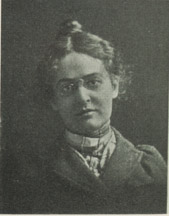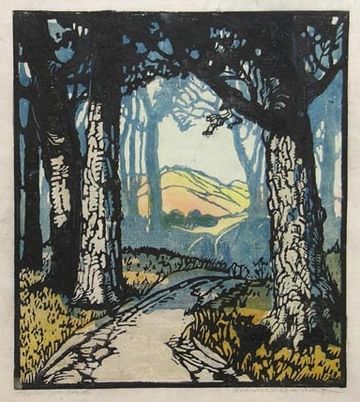Frances Gearhart facts for kids
Quick facts for kids
Frances Gearhart
|
|
|---|---|

Frances Gearhart, 1900
|
|
| Born |
Frances Hammell Gearhart
January 4, 1869 |
| Died | April 4, 1958 (aged 89) Pasadena, California, United States
|
| Nationality | American |
| Alma mater | State Normal School at Los Angeles (1891) |
| Known for | Printmaking Watercolor |
Frances Gearhart (born January 4, 1869 – died April 4, 1958) was an American artist. She was known for her bold and colorful woodcut and linocut prints. Her art often showed the beautiful landscapes of America. She especially focused on California's coasts and mountains. Her work is seen as a "vibrant celebration of the western landscape." Frances Gearhart is one of the most important American color block print artists of the early 20th century.
Contents
Early Life and Education
Frances Hammell Gearhart was born on January 4, 1869. Her birthplace was Sagetown, Illinois, in the United States. In 1888, she moved to California. The next year, she began studying at the State Normal School at Los Angeles. This school is now known as UCLA.
She graduated in 1891. After graduating, she worked as an English teacher in high school for several years. Frances also received more art training. She learned from artists like Charles Herbert Woodbury and Henry Rankin Poore. She might have also taken a class from Frank Morley Fletcher. He helped bring Japanese woodblock printing techniques to other parts of the world.
Art Career and Style
Frances Gearhart had one of her first public art shows in 1909. It was a joint exhibit with other high school teachers in Los Angeles. She showed a collection of "striking water color scenes." In March 1911, she had her first solo exhibition. It was at the Walker Theatre Gallery. An art critic from the Los Angeles Times said her 35 watercolor landscapes were "full of movement."
Even early on, critics noticed her skill with colors. They believed she would become "one of the strongest of California's landscape painters." She continued to show watercolors for several years. Later, she started making prints, especially linocuts and woodcuts. These became her favorite art forms.
Printmaking Techniques
Frances learned block printing from her sisters, May and Edna. They were also artists. Her sisters had learned this technique from Arthur Wesley Dow. He taught at the Ipswich Summer School of Art in Massachusetts. Frances used a traditional Japanese relief-printing method. This meant she made a separate block for each color in the final print. Some of her prints needed up to 8 different blocks.
It is thought that she created about 250 different prints. Each print was made in editions of 20 to 50 copies. Every single print was made by hand.
Artistic Influences and Themes
Frances Gearhart was influenced by the Arts and Crafts movement. Her prints often used strong, dark lines, either black or dark blue. She combined these with rich colors in the front of the picture. The backgrounds were often softer and muted. She frequently included paths, roads, or waterways in her art. These elements helped lead the viewer's eye into the picture. She also used tall, strong trees to help balance her compositions.
Her unique style blended sharp lines with soft colors and light. This made her art perfect for showing California's special mix of "serene and stark beauty."
Art Societies and Exhibitions
Frances became a member of the California Society of Etchers in San Francisco. This group is now called the California Society of Printmakers. In 1919, five of her color prints were chosen for their Eighth Annual Exhibition.
In 1919, Gearhart also joined the Print Makers Society of California (PMSC). She became one of the leaders of this group in its early years. In 1920, she was asked to create the first of the PMSC's yearly gift prints. The PMSC exhibitions often started in Los Angeles and then traveled to northern California. Between 1921 and 1942, newspapers in the Bay Area often mentioned her work. Her art was shown at places like the Oakland Art Gallery and the San Francisco Museum of Art. Frances often spent summers sketching on the Monterey Peninsula. In 1921, five of her block prints attracted a lot of attention at the Carmel Annual show.
She also joined other art groups, such as the Prairie Print Makers and the American Federation of the Arts.
Later Career and Legacy
By 1923, Frances Gearhart was able to stop teaching. She could then spend all her time on art. She and her sisters, May and Edna, opened an art gallery in Pasadena, California. There, they organized exhibitions for the PMSC and for important European printmakers.
In October 1922, Frances and May had a joint exhibition. It showed their color etchings and woodblock prints at the Chouinard Art Institute in Los Angeles. In the fall of 1923, the sisters created a larger version of this exhibit for the Los Angeles Museum. After this, her work was shown in other museums. These included the Brooklyn Museum, the Toronto Museum, and the Worcester Art Museum. Many museums and art institutions now own her work.
In June 1926, Frances gave a lecture and had a solo show. It featured her linoleum block prints at the UCLA Art Gallery. The next month, she sent her color print Twilight to a graphic arts exhibition in Paris. During her lifetime, Frances showed her art at over 30 places across the country. She also received several awards. One was the 1933 Purchase Prize at the International Exhibition of Print Makers.
After 1940, Frances Gearhart made fewer new artworks. This was because her eyesight began to fail. She passed away in Pasadena on April 4, 1958.
In 1990, the Cheney Cowles Museum held an exhibit of her work. In 2009, the Pasadena Museum of California Art put on a large show looking back at her art.
See also
 In Spanish: Frances Gearhart para niños
In Spanish: Frances Gearhart para niños


